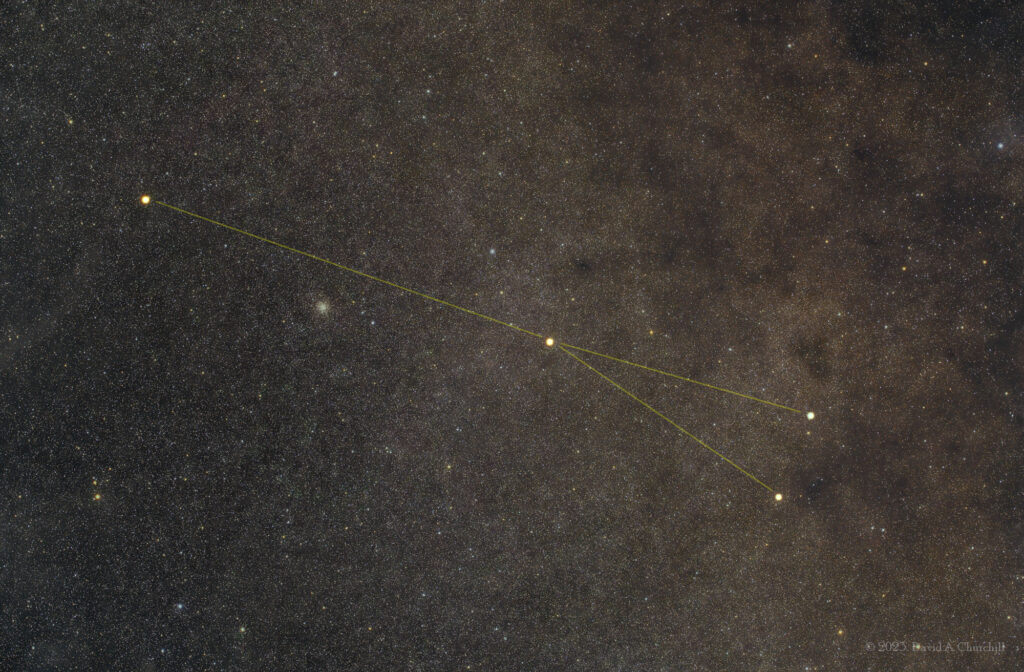Constellation of Sagitta
The Arrow, Wide field view
- Description
- Technical
- Links
Sagitta is a dim but distinctive constellation in the northern sky. Its name is Latin for ‘arrow’, not to be confused with the significantly larger constellation Sagittarius ‘the archer’. It was included among the 48 constellations listed by the 2nd-century astronomer Ptolemy, and it remains one of the 88 modern constellations defined by the International Astronomical Union. Although it dates to antiquity, Sagitta has no star brighter than 3rd magnitude and has the third-smallest area of any constellation. The ancient Greeks called Sagitta Oistos ‘the arrow’, and it was regarded as the weapon that Hercules used to kill the eagle (Aquila) of Jove that perpetually gnawed Prometheus’ liver.
The four brightest stars make up an arrow-shaped asterism located due north of the bright star Altair. Covering 79.9 square degrees and hence 0.194% of the sky, Sagitta ranks 86th of the 88 modern constellations by area. Only Equuleus and Crux are smaller. Sagitta is most readily observed from the late spring to early autumn to northern hemisphere observers. Sagitta is bordered by Vulpecula to the north, Hercules to the west, Aquila to the south, and Delphinus to the east. The three-letter abbreviation for the constellation, as adopted by the International Astronomical Union in 1922, is “Sge”. Celestial cartographer Johann Bayer gave Bayer designations to eight stars, labelling them Alpha to Theta. Ptolemy saw the constellation’s brightest star Gamma Sagittae as marking the arrow’s head, while Bayer saw Gamma, Eta, and Theta as depicting the arrow’s shaft.
The band of the Milky Way and the Great Rift within it pass though Sagitta, with Alpha, Beta and Epsilon Sagittae marking the Rift’s border. Just left of the center of this image and located between Beta and Gamma Sagittae is Messier 71, a very loose globular cluster mistaken for some time for a dense open cluster. At a distance of about 13,000 light-years from Earth, it was first discovered by the French astronomer Philippe Loys de Chéseaux in the year 1745 or 1746. The loose globular cluster has a mass of around 53,000 M☉ and a luminosity of approximately 19,000 L☉.
The four brightest stars make up an arrow-shaped asterism located due north of the bright star Altair. Covering 79.9 square degrees and hence 0.194% of the sky, Sagitta ranks 86th of the 88 modern constellations by area. Only Equuleus and Crux are smaller. Sagitta is most readily observed from the late spring to early autumn to northern hemisphere observers. Sagitta is bordered by Vulpecula to the north, Hercules to the west, Aquila to the south, and Delphinus to the east. The three-letter abbreviation for the constellation, as adopted by the International Astronomical Union in 1922, is “Sge”. Celestial cartographer Johann Bayer gave Bayer designations to eight stars, labelling them Alpha to Theta. Ptolemy saw the constellation’s brightest star Gamma Sagittae as marking the arrow’s head, while Bayer saw Gamma, Eta, and Theta as depicting the arrow’s shaft.
The band of the Milky Way and the Great Rift within it pass though Sagitta, with Alpha, Beta and Epsilon Sagittae marking the Rift’s border. Just left of the center of this image and located between Beta and Gamma Sagittae is Messier 71, a very loose globular cluster mistaken for some time for a dense open cluster. At a distance of about 13,000 light-years from Earth, it was first discovered by the French astronomer Philippe Loys de Chéseaux in the year 1745 or 1746. The loose globular cluster has a mass of around 53,000 M☉ and a luminosity of approximately 19,000 L☉.
Telescope: Askar FRA300pro f5
Mount: Astro Physics Mach-1
Camera: ZWO ASI6200MC pro
Guider: ZWO Off-Axis-Guider / ZWO120MM Mini
Filters: Optolong UV/IR Cut Filter (Luminance)
Lum: 48×5 mins = 240 mins
Total Imaging Time: 4h 00m
Data Imaged remotely over 2 nights during June 2023.
Data acquisition & Processing by David Churchill.
None

